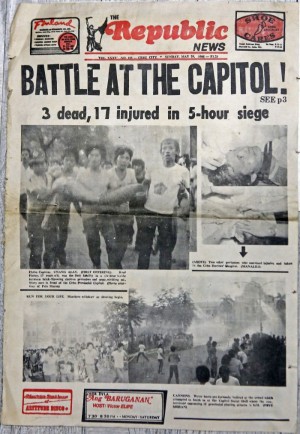I was really stunned. The newspaper clippings that featured my cartoons brought back lots of memories.”
A teary-eyed Tonee Despojo, photo editor of Cebu Daily News, muttered as he viewed digital reproductions of yellowing pages of The Freeman with his editorial cartoons featuring the late Ribomapil “Dodong” Holganza Sr. appearing in the computer monitor.
Despojo worked for The Freeman for 16 years before he moved to CDN. He was a cartoonist before trying his hand in photography where he has carved a name for himself as one of the region’s best.
“I was just 19 years old then, first year college ko ana and about eight months on the job when I drew the cartoons,” the photo guru, popularly known as Tatay Tonee, said.
Graphic designer Jakob Juntilla, with his mouth agape, was amused as elder members of the CDN editorial staff were exchanging “throwback” anecdotes of the tumultuous years that led to the People Power Revolution. Juntilla was born in 1986, the Edsa year. Tatay Tonee’s obra preceded Jakob’s existence by two years.
CDN photojournalist Lito Tecson kept on narrating from memory what was happening then as he snapped photos of the “preserved” copies of the Republic News, Sun Star Daily and The Freeman that were laid out on the floor in the office of media executive, Rosemarie Holganza-Borromeo, daughter of the late freedom fighter.
“Naa mi ana. Padung mi sa Capitol kay jail guard man sa una ang Papa nako (We were there. We were on the way to the Capitol as my father was then working as a jail guard),” Tecson, who was barely 16 when a pitched battle between police and protesters occurred along Osmeña Blvd.
Dodong’s files
The “old” newspapers were freshly unearthed from the files of Rosemarie’s father, Dodong, who passed away last Jan. 25 or exactly a month short of the 29th anniversary of the day the Marcoses fled the country after the 1986 people’s revolution.
The seemingly forgotten May 1984 Cebu siege was such a big story that it made the pages of the New York Times. The incident demonstrated the “widespread dissatisfaction” with the Marcos government which the dictator tried to downplay as many of his political allies lost in the Batasang Pambansa elections.
“Mr. Marcos’s comments, on national television, came hours after one person was killed and 27 others, including 8 soldiers, were wounded when government troops broke up a rally in the central Philippine provincial capital of Cebu. Several thousand demonstrators armed with firebombs and bricks had been protesting what they said was fraud in the vote counting,” read the Times dispatch filed by Steve Lohr and published May 21, 1984.
Police identified the fatality in the Cebu clash as Raul Pintoy, 17, who was killed after he was shot in the neck after soldiers and policemen fired at protesters. Marcos blamed the opposition leaders in Cebu for the violence.
“Mr. Marcos said his ruling party had not tampered either with the election procedures or the vote count. The Cebu incident, Mr. Marcos said, was instigated by opposition leaders to stop the vote canvassing because the ruling party was leading the race for six assembly seats in the region. But according to the National Citizens’ Movement for Free Elections, a group set up to monitor the vote, opposition candidates were ahead in five of six races,” the Times report said.
Dodong Holganza was arrested on Christmas day of 1982 together with his son, former provincial board member Ribomapil “Joeyboy” Holganza Jr., Dr. Filemon Alberca and Constantino Loloy and were accused of planning to launch a revolution in Cebu.
While behind bars in Camp Sotero Cabahug in Cebu City, Holganza was instrumental in organizing the Panaghiusa, a Visayas-based political alliance. He was among the party’s candidates in the 1984 elections and was not allowed to campaign for his candidacy.
Antonio Cuenco, Marcelo Fernan, radio personality Inday Nita Daluz were the only Cebuano oppositionists who made it to the Batasan. Holganza was released from detention in 1985.
